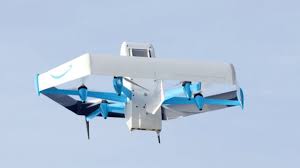NEW YORK (AFP): Amazon on Wednesday said it hopes to expand drone delivery into Britain and Italy by late next year, as it unveiled new warehouse robots and tech in its race to get shoppers what they want quickly.
The Seattle-based e-commerce colossus said it will expand drone delivery of certain purchases to a third US state as well as to the two European countries by the end of 2024.
Amazon delivery drones are already at work in California and Texas, and a new MK30 model will be able to operate in more extreme weather conditions than those currently in use, Amazon Prime Air vice president David Carbon said during a marketing event.
“Our customers have always wanted things faster and I think this is a way we can get to it at scale,” said Prime AI director of engineering Jason Patrao, adding that the drone program, while currently small, “is going to be something that I think we will all get used to.”
Amazon has also installed a new robotics system called Sequoia in one of its Texas logistics centers, the company said.
The system features automated vehicles, gantry cranes, mechanical arms, computer vision technologies and ergonomic workstations for employees, a presentation showed.
Amazon already uses 750,000 robots in its warehouses, but the idea is to make the various machines more interoperable, according to executives.
“It becomes magical when you blend multiple robotics systems with our amazing people,” said Amazon Robotics chief technologist Tye Brady.
Sequoia can identify and put away stock in warehouses “up to 75 percent faster” than was previously possible, the company said in a statement.
And order processing time can be reduced by 25 percent in best-case scenarios.
“This means we can list items on sale on Amazon.com more quickly, benefitting both sellers and customers,” Amazon said.
Traditional brick-and-mortar stores still account for about 80 percent of retail business, but sales are likely to shift more online the more such immediate gratification through fast delivery becomes available, analysts said.
“The better they get at delivery, the more it continues to grow the e-commerce market overall and Amazon’s place within that market,” said Insider Intelligence analyst Andrew Lipsman.
The popular online shopping platform became a lifeline for many during the pandemic, but since this year it has been facing a new kind of competition from Chinese e-commerce apps.
Fashion retailer Shein and especially Temu, which offers beauty products, homeware and electronics, have won over many consumers with their low prices.
“Given how aggressively Temu is trying to compete with Amazon and the money they seem to be willing to spend on logistics and getting cheap goods to people, I’m sure Amazon has some level of concern,” Lipsman said.
– Jobs versus robots –
Without specifying whether jobs would be lost through the use of robots, Amazon emphasized the gains in terms of safety, sparing workers from repetitive tasks and even creating jobs.
“Over the past ten years, we have installed hundreds of thousands of robotic systems while creating hundreds of thousands of jobs,” the group stressed.
“We think that the repetitive, the mundane work that people do, we do see that shifting more to robotics,” said Scott Dresser, vice president for Amazon robotics.
“There’s also an opportunity to make things safer, when people (are) bending and lifting heavy objects, when people are walking miles in the fulfillment center,” he said.
Amazon, the second-largest employer in the US, just behind Walmart, will also be testing android-like machines from Agility Robotics to carry plastic bins.
“There’s about a million unfilled logistics, manual labor jobs” in the United States currently, said Agility cofounder Damion Shelton.
“The problem is not that you’re even taking a job… The problem is there’s no person to even do the work,” he said.
But increased productivity via robots won’t fix underlying Amazon worker issues, critics say.
“It’s not going to change their logic. And their logic is ‘use these workers up and throw them away’,” said Sheheryar Kaoosji, executive director of the Warehouse Worker Resource Center, a nonprofit dedicated to improving warehouse industry conditions in southern California.







